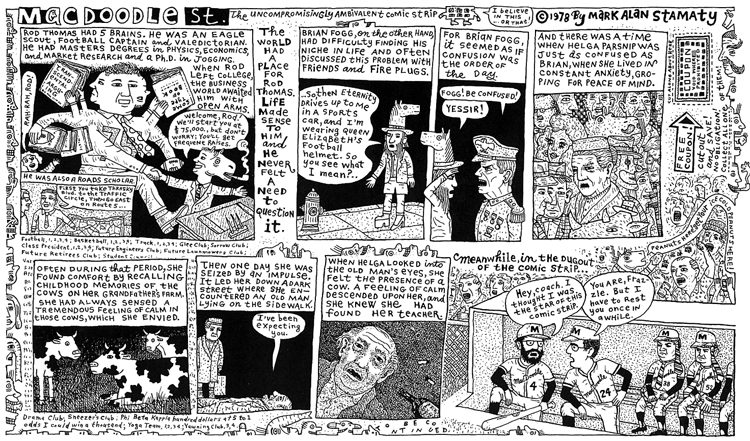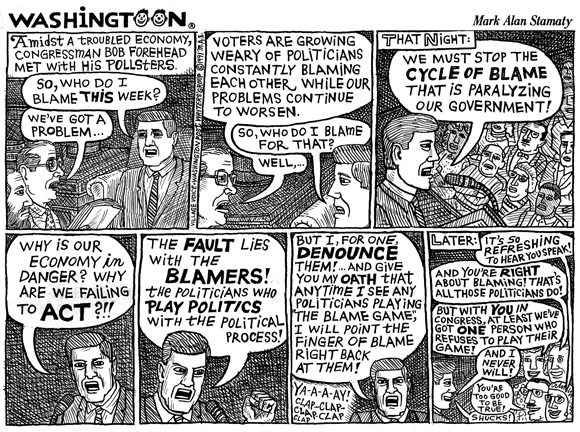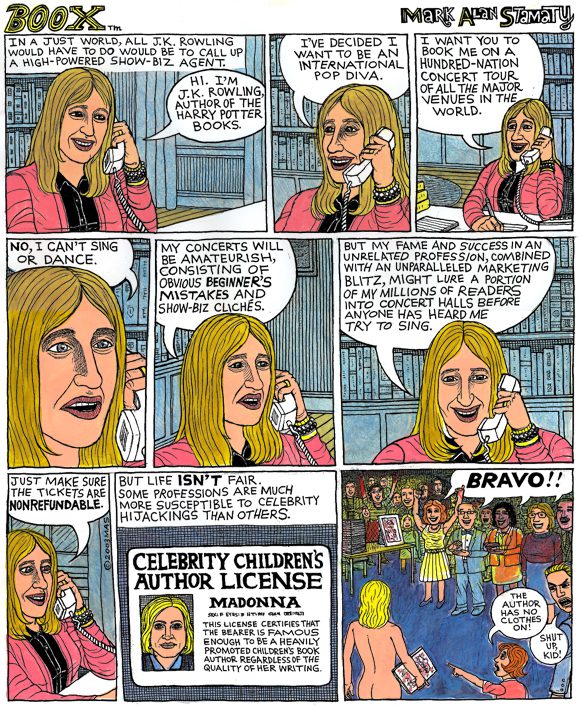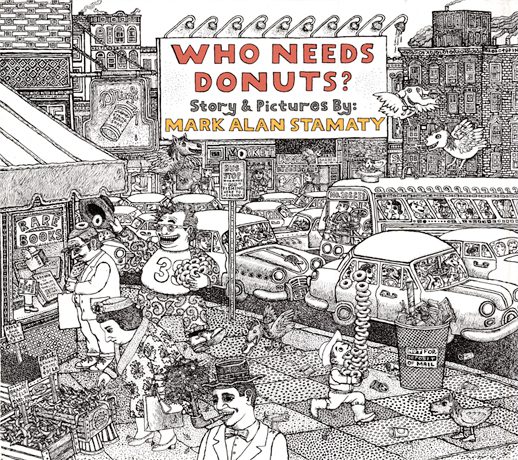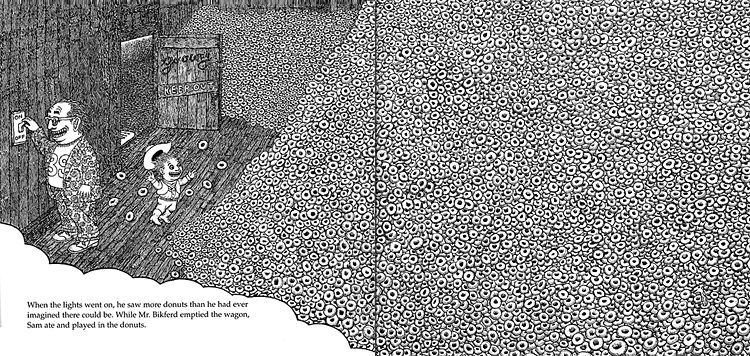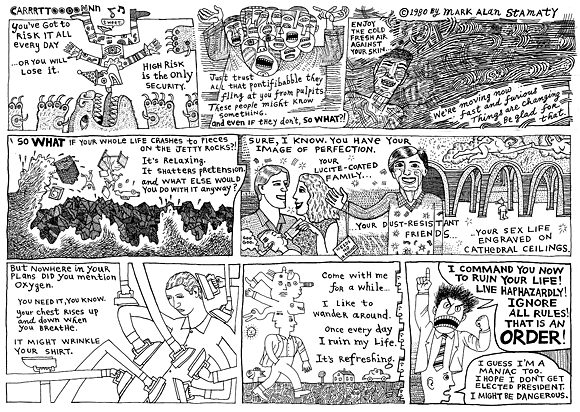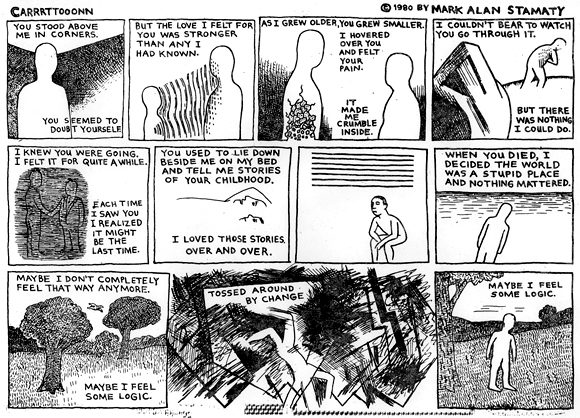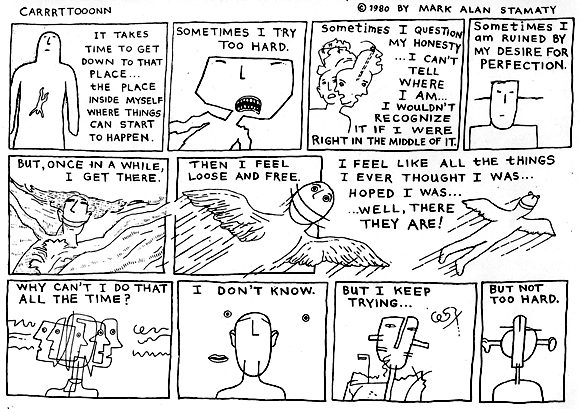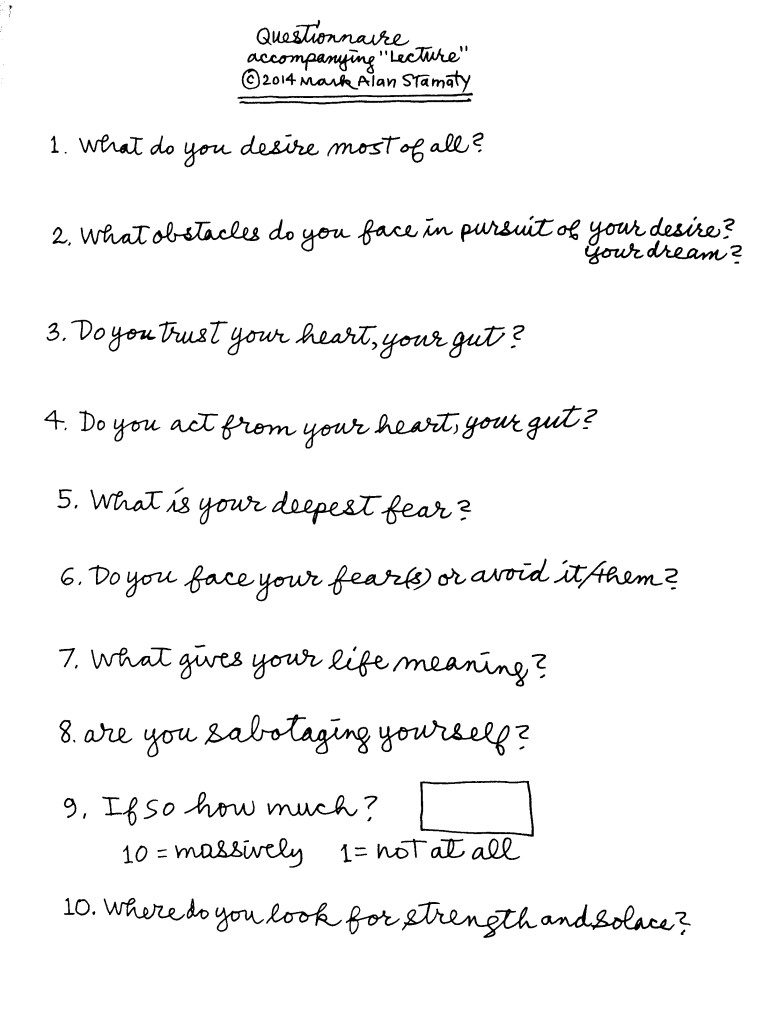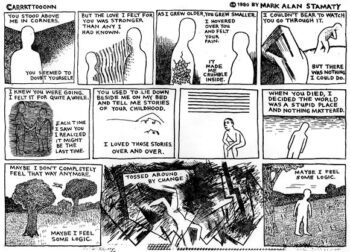
The New York Comics & Picture-Story Symposium is a weekly forum for discussing the tradition and future of text/image work. Open to the public, it meets Tuesday nights at 7-9 p.m. EST in New York City. Presentations vary weekly and include everything from historical topics and technical demonstrations to creators presenting their work. Check out upcoming meetings here.
At the 73rd meeting of the New York Comics and Picture-story Symposium, cartoonist Mark Alan Stamaty presented on his life and work in a talk which included personal anecdotes, audience participation, and even an Elvis impersonation.
Stamaty began his talk by giving an overview of his work, which included his strips in the Village Voice—an outlet which, according to Ben Katchor’s introduction, made Stamaty a “household name” in the cartooning world. This included a strip called MacDoodle St., published 1977-1978, which Stamaty describes as “when the comic strip got drunk”; here, Stamaty experimented with the format of the comic strip, especially by having the content of the comic strip refer to its own form.
Stamaty’s tenure at the Voice also included a lesser-known strip called Carrrttooonn in 1980, which he discussed at length later in the talk.
After the success of these two strips, Meg Greenfield, editorial page editor of the Washington Post, asked Mark Stamaty to create a strip about Washington, D.C. The strip, called Washingtoon, included a character called “Congressman Bob Forehead,” the “head of a JFK Lookalike Caucus.” Stamaty went on to become a political cartoonist for Time Magazine from 1994 to 1996.
Stamaty also presented his monthly comic strip Boox, created for the New York Times Book Review from 2001 to 2003. The inspiration for these pages ranged from Bob Dylan writing his memoir and being unable to recover events from his own life, to Madonna’s attempt to write children’s literature, and Al Franken’s debate with Bill O’Reilly.
He then discussed other artwork such as the uncommissioned “City Drawing,” which won a gold medal from the Society of Illustrators, and his comic “A Cartoon Legacy,” published in The New Yorker in 2011, about the experience of growing up with two cartoonist parents. Stamaty, who was the only child of one Jewish and one Greek parent, was born in New York and raised in New Jersey. His father, with whom he was very close, decided to become a cartoonist at the age of 14, after a doctor informed him that he had a heart condition and must therefore have a “sedentary job.” Thus, his father decided to become a single-panel cartoonist, and Stamaty was born “with cartooning in his blood.”
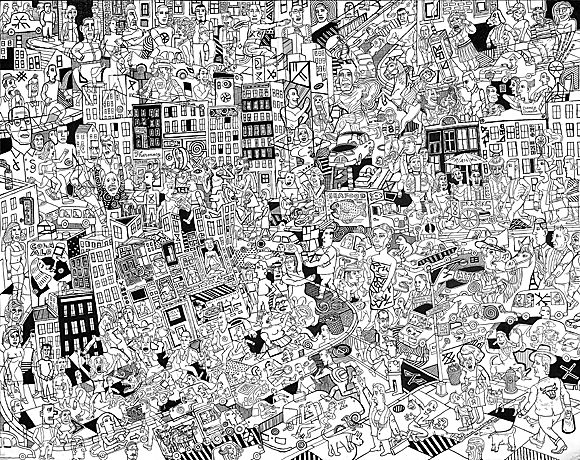
Stamaty then discussed his children’s books, including Who Needs Donuts? (1973, 2003), Where’s My Hippopotamus? (1977), and Yellow, Yellow, written by Frank Asch (1971). Although the style of Yellow, Yellow, published when Stamaty was only 22 years old, was praised by Publishers Weekly, his subsequent work Who Needs Donuts? was bashed by the same publication, although the critic later changed her mind and regretted her bad review.
Then, as Stamaty stated: “I had a frustration—I wanted an adult audience. I wanted to write adult things. My children’s books were always in between… I also wanted to write comic novels of some sort.” He then created a panoramic centerfold of both Greenwich Village and Times Square in the style of Who Needs Donuts? for the Voice, and was given a weekly strip which became MacDoodle St. However, with time, Stamaty’s comic strips became increasingly tense, which resulted in an artistic and literary stage fright. He decided to take a month leave from the strip, and his father passed away during this interim. Feeling “the life had gone out of MacDoodle St.,” Stamaty decided to create something new: “I said to myself: I’m going to do a comic strip with one goal in mind—I just want to enjoy doing it, and I don’t care if other people like it.” The result of this investigation was Carrrttooonn, an often autobiographical, heavily experimental comic strip about Stamaty’s process of cartooning.
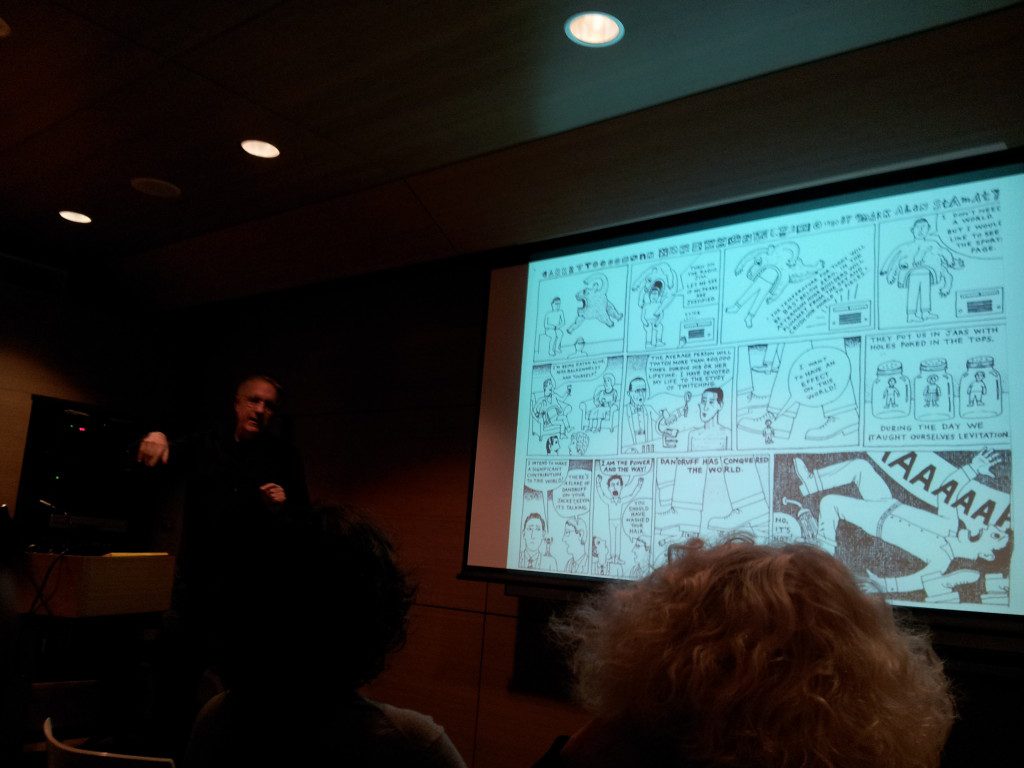
Having begun this project accidentally, and with no expectations, Stamaty was surprised by the encouragement of his friends and the editors at the Voice. Many even considered this strip a work of poetry; indeed, he was even contacted by someone from the Public Theater to do a poetry reading from Carrrttooonn. This person from the Public Theater, Stamaty notes, became the love of his life.
“This strip was about pursuing a feeling,” Stamaty describes. The themes ranged from an investigation into the nature of a panel, to a strip about his father’s death, to poetic and playful non-sequitors. Indeed, many of the strips do seem to approach poetry; one panel from Carrrttooonn states: “Life is a rolling thermos bottle down a rocky hill. We are all a quart of coffee mixed with broken glass.” “It came from something personal, a kind of truth,” Stamaty describes.
The strip was widely praised; Matt Groening, for example, said he saved all of Stamaty’s strips in the Voice, and looked at them to “loosen himself up.” Harvey Pekar, however, was not as complimentary, and even bashed Stamaty’s Voice strips in the autobiographical comic American Splendor. On one page, Pekar’s character complains about another cartoonist getting a strip in the voice: “And his work really SUCKED! It was so coy and precious. He seemed like a twelve-year old trying to show how sensitive he was.” Here, R. Sikoryak pointed out that Pekar also complained about Art Spiegelman for years, and hated Maus. Stamaty responded by saying that he in fact admired Pekar, and wished he could have met him, also praising the 2003 film based on the graphic novel.
Returning to the theme of Carrrttooonn, Stamaty claimed that “I was trying to get to a place… I wanted it to be about discovery. Something like meditation.”
Stamaty then explained his concept of the “heart center” from which our most fulfilling work arises, describing his experiences walking through NYC at night, letting himself feel unconsciously guided. At this moment, Stamaty announced that he wanted to engage the audience in a meditative exercise, and distributed a (copyrighted) handwritten questionnaire. Stamaty instructed the audience to fill out the questionnaire, then to turn over the paper and think about the things they wrote via guided meditation. Then everyone was asked to produce images or scribbles on the back of the sheet of paper, after which the pages were displayed anonymously for everyone to browse at their leisure.
During the Q&A, questions and comments ranged from Stamaty’s similarity to Bill Watterson, to the Chinese meditative practice of using “scholar rocks,” to Stamaty’s transition to Washingtoon after his work at the Voice. The talk ended with Stamaty doing his infamous impersonation of Elvis Presley, which he once performed in front of Bill Clinton in the Oval Office.
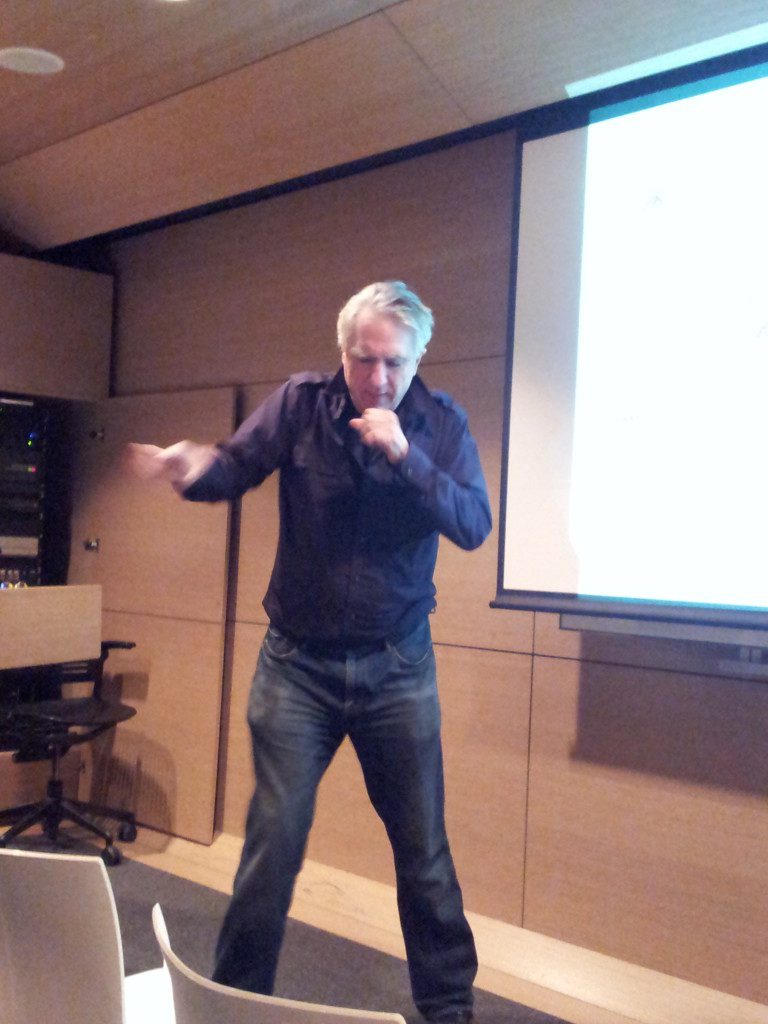
Image list:
1. MacDoodle St. in The Village Voice, 1978, Mark Alan Stamaty
2. Washingtoon in The Washington Post, Mark Alan Stamaty
3. Boox in The New York Times Book Review, Mark Alan Stamaty
4. “City Drawing,” Mark Alan Stamaty (received gold medal from Society of Illustrators)
5. “Who Needs Donuts?” (cover), 1973/2003, Mark Alan Stamaty
6. “Who Needs Donuts?” (inside) 1973/2003, Mark Alan Stamaty
7. Stamaty discussing his work at the Comics Symposium, Parsons, New York City, 2014
8. Carrrttooonn in The Village Voice, 1980, Mark Alan Stamaty
9. Carrrttooonn in The Village Voice, 1980, Mark Alan Stamaty
10. Carrrttooonn in The Village Voice, 1980, Mark Alan Stamaty
11. Questionnaire accompanying lecture at the Comics Symposium, 2014, Mark Alan Stamaty
12. Stamaty’s Elvis impersonation at the Comics Symposium, Parsons, New York City, 2014
About the author: Julia Alekseyeva is an illustrator and PhD student of Comp Lit at Harvard. She is currently working on a nonfiction graphic novel entitled The Soviet, and is writing a dissertation on Soviet, French, and Japanese film. She lives in Brooklyn, NY. You can see her work here.

